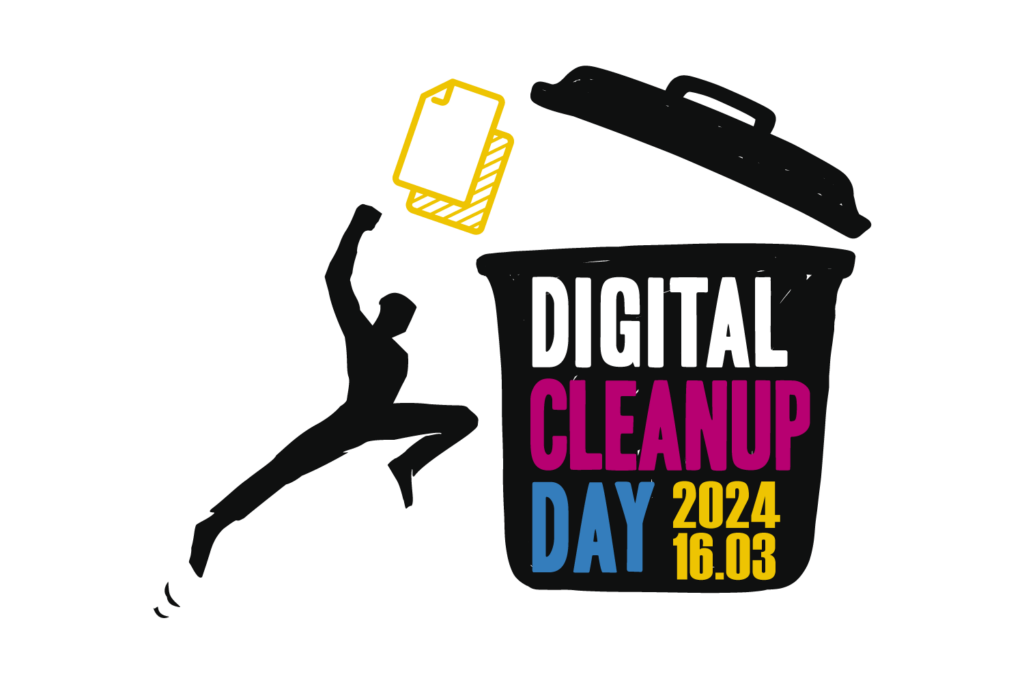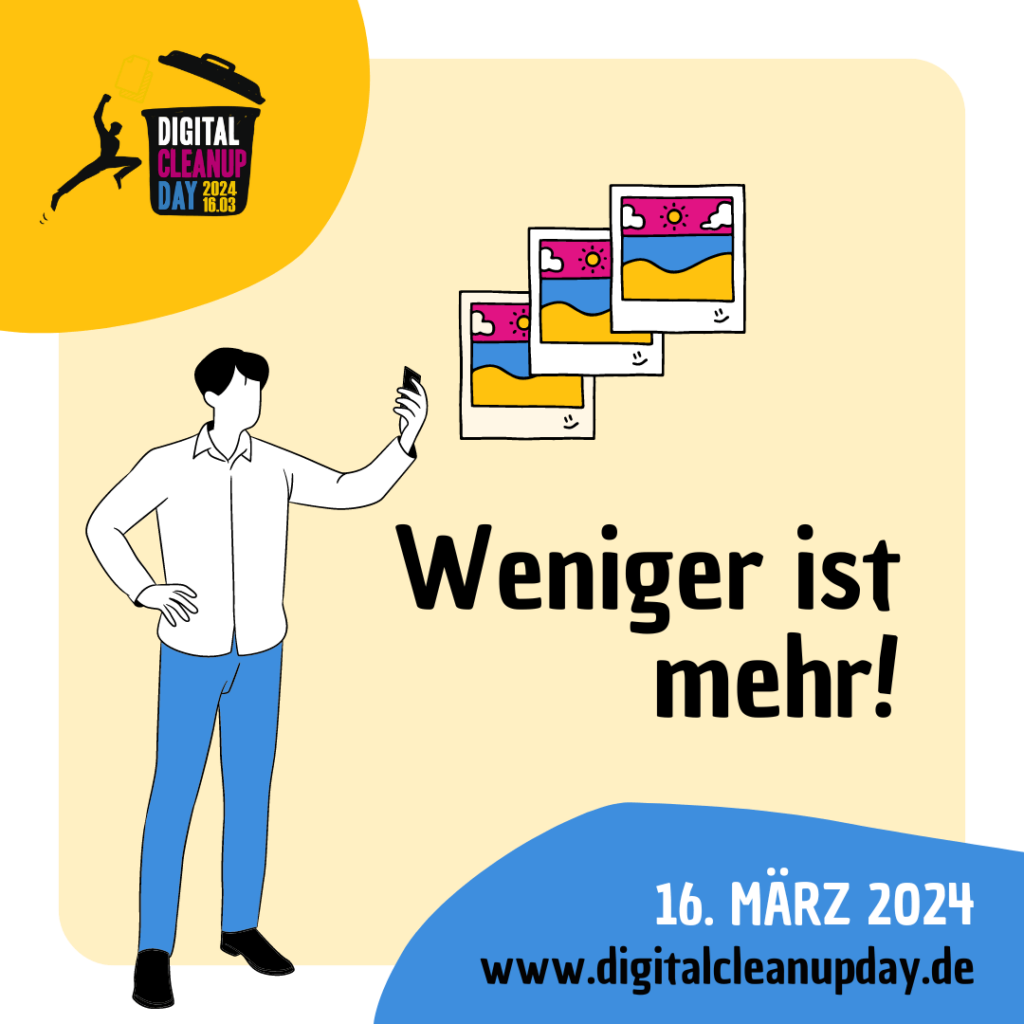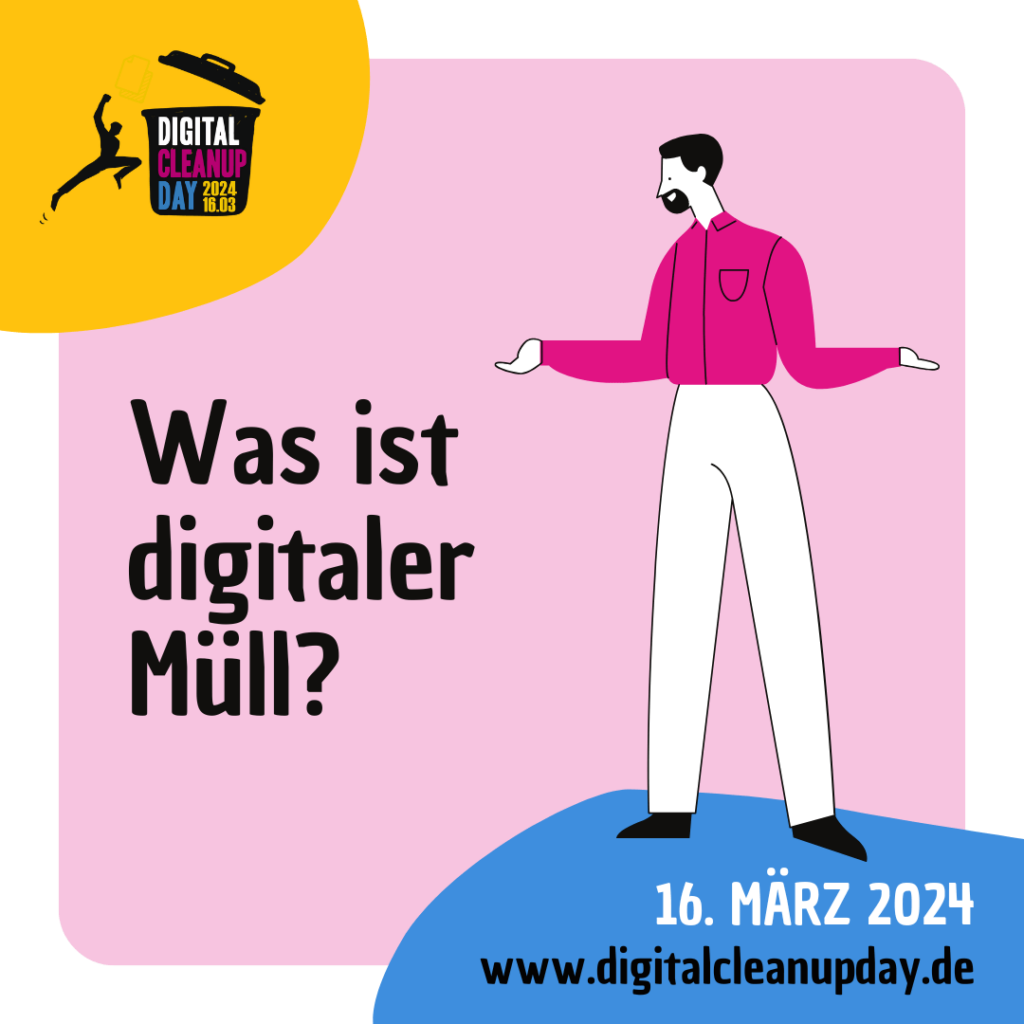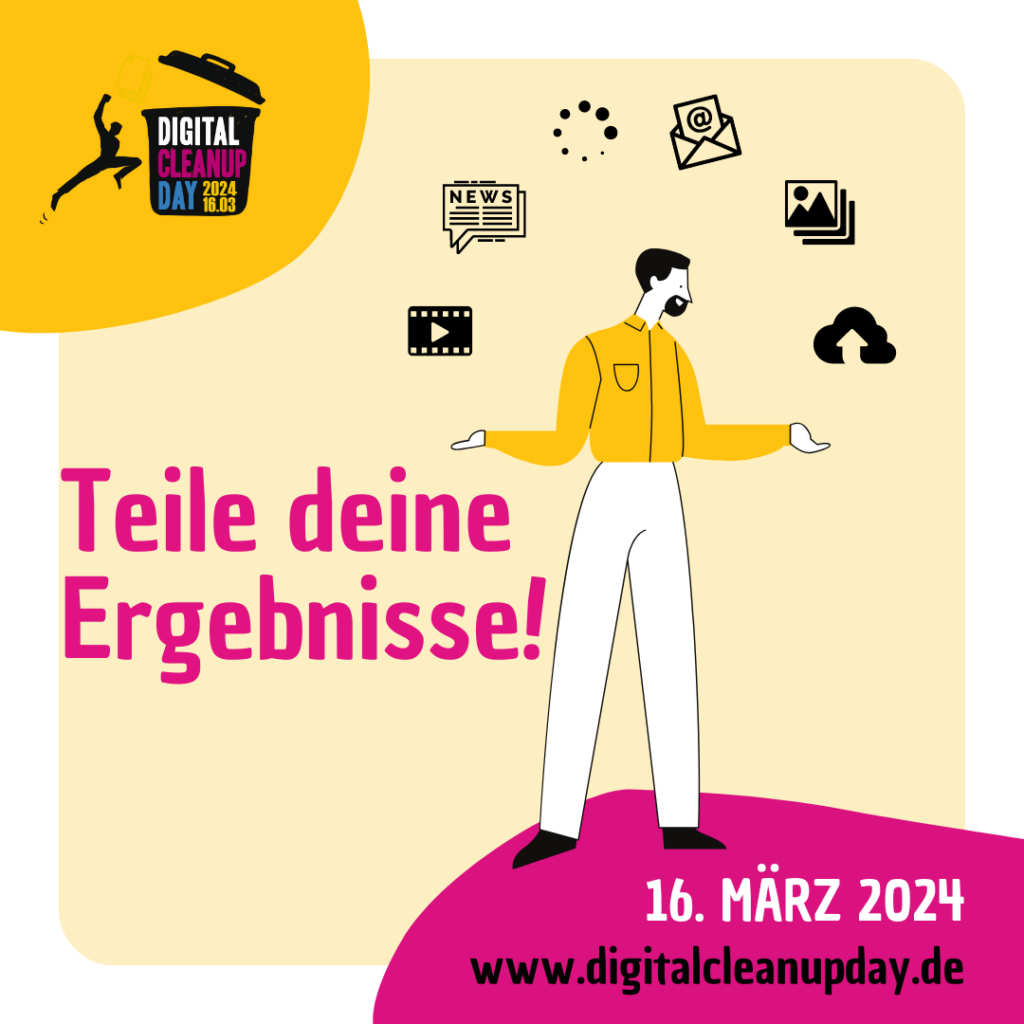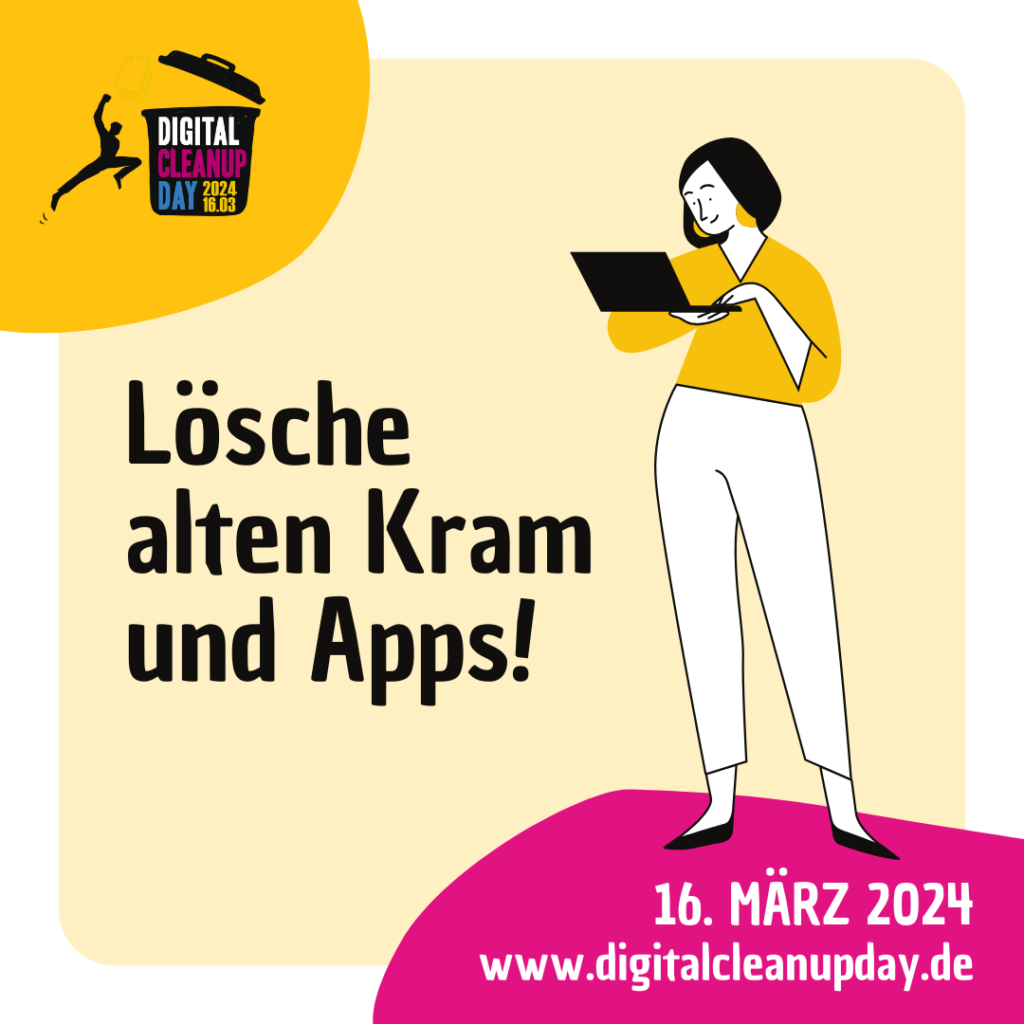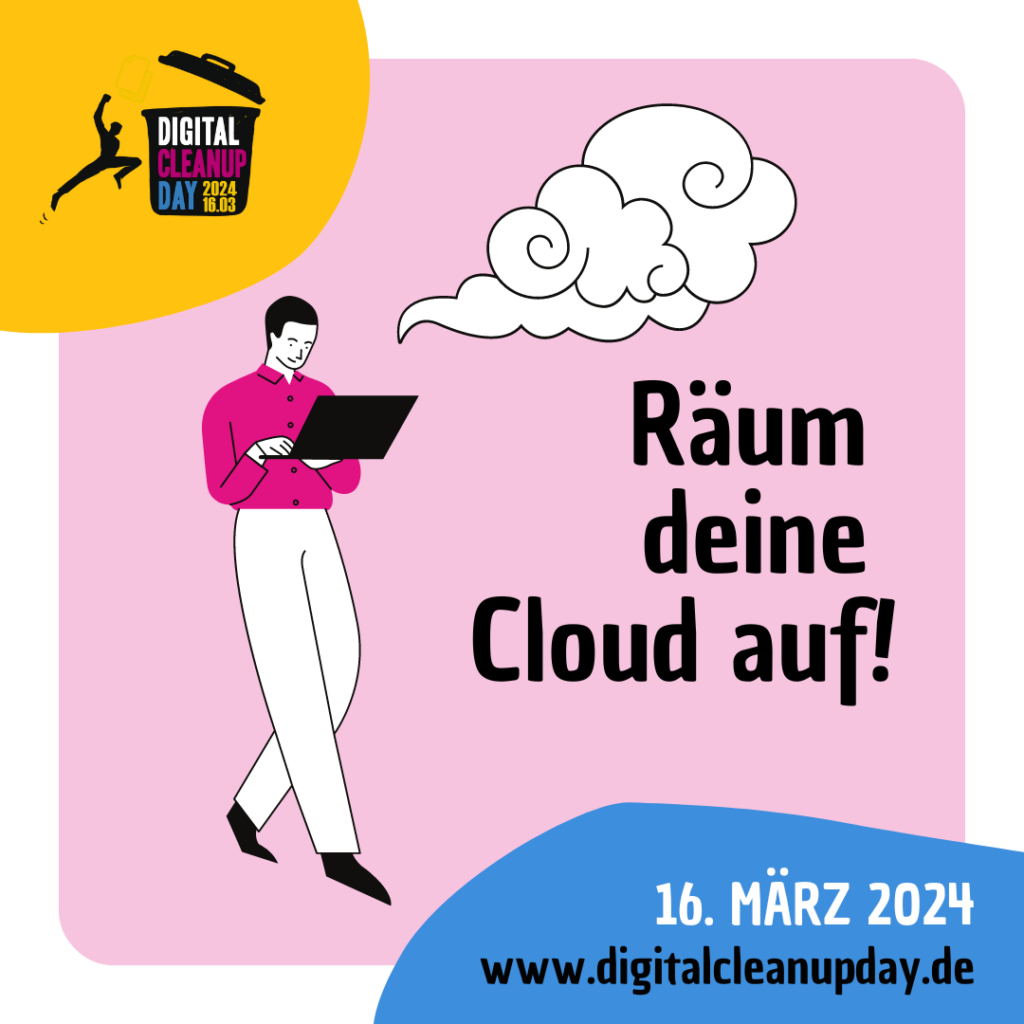take part in the digital cleanup day
Whether we are at work, relaxing at home or traveling, the internet, data and the cloud are omnipresent in our daily lives. At a time when digital activities account for a significant proportion of global CO2 emissions, it is becoming increasingly important to be aware of the impact of our online use.
Holger Holland, initiator of Digital Cleanup Day in Germany, draws attention to this: “Every movie streamed, every app installed, every email written causes CO2, every like has a footprint and the cloud is not a cloud in the sky, but consumes a lot of energy. Behind this digital screen are data centers that continuously process vast amounts of data and consume huge amounts of electricity in the process. Every day! over 300,000 tons of CO2 (~71,000,000 EUR or ~1,370,000 flights from Munich to London!) are generated daily by spam email.”
This highlights the hidden environmental impact of digital activities, where data centers continuously process data and consume significant amounts of electricity.
The annual emission of 900 million tons of CO2 from digital data even exceeds the annual emissions of countries like Germany. This emphasizes the importance of reviewing our digital energy consumption, our habits and the qualitative handling of data. “A high data quality and data culture is not only crucial for the efficiency of AI systems, but also helps to use energy and resources more efficiently and thus protect our planet,” says Holger Holland.
On a Digital Cleanup Day we have the opportunity to take action. Cleaning up unnecessary digital content not only reduces CO2 emissions, but also increases the performance of our devices. This is a simple step to reduce our digital footprint and make a positive contribution to environmental protection.
*Andrae, Anders. (2020). Hypotheses for Primary Energy Use, Electricity Use and CΟ2 Emissions of Global Computing and Its Shares of the Total Between 2020 and 2030. WSEAS Transactions on Power Systems.
https://www.iea.org/reports/global-energy-co2-status-report-2019/emissions
https://www.umweltbundesamt.de/en/indicator-greenhouse-gas-emissions#at-a-glance
https://holgerholland.de/thesis-der-einfluss-von-soft-skills-auf-die-nachhaltige-kommunikation-von-virtuellen-teams-in-kleinen-und-mittelgrossen-umweltschutz-npos/
Be cool - don't feed global warming with digital waste!
Reduce your carbon footprint and take part in a Digital Cleanup!
Would you have known?
HOW DO I DO A DIGITAL CLEANUP?
INSTRUCTIONS FOR EVERYONE
TIDY UP YOUR SMARTPHONE
Remove all applications that you have not used for some time or have only used a few times. Be honest and brave! Delete all the unnecessary, forgotten, old apps and games that you have downloaded but not even tried. You won't use them again later - for sure! But they consume energy even when they're not being used and can use up hundreds of megabytes of data every month for updates.
Don't forget to delete all user accounts (including emails) and any data you created when you were 15 and haven't accessed for a decade. This will speed up your phone, increase battery life and available memory - it's always worth having as few apps as necessary.
Review your photos and videos. Deleting unnecessary and duplicate files can free up dozens of gigabytes of valuable storage space.
CLEAN UP YOUR PC OR LAPTOP
Clean your PC and delete all files that are duplicates or have become unusable. Sort your photos, delete duplicates and blurred photos. Go through your videos and delete all unnecessary files. Archive the important files. You'll be amazed at the amazing things you'll find on your computer!
CLEAN UP YOUR MAILBOX
Sort your emails by age and archive all those that are older than a year, for example. Unsubscribe from newsletters that you don't read at all. Select long conversations, select the last conversation point and DELETE the rest of the history. This also works wonderfully with all messengers, such as WhatsApp. Be brave and click on the DELETE button :)
INTRODUCE NEW ROUTINES
The toolbox
Here you can find information, instructions and checklists for successful participation in Digital Cleanup Day.
Wie mache ich am Digital Cleanup Day mit? Eine Checkliste für Privatpersonen
DCD 2023 Leitfaden Digital Cleanup Day für Einzelpersonen_GER
Wie mache ich am Digital Cleanup Day mit? Eine Checkliste für Unternehmen
Wie mache ich am Digital Cleanup Day mit? Eine Checkliste für Gemeinden, Städte und Kommunen
Eine Checkliste für Schulen und Hochschulen
DCD 2023 Leitfaden Digital Cleanup Day für Schulen und Hochschulen_GER
Eine Anleitung zum aufräumen meines E-Mail-Postafches
Eine Anleitung zum aufräumen meines Smartphone und Tablet
Eine Anleitung zum aufräumen meines Computer und Laufwerk
Companies and organizations can make changes in their daily workflow that help to significantly reduce the environmental footprint of digital systems. This requires a little time and a willingness to make strategic decisions and simple changes. When thinking about your workflows, you need to evaluate what works and what doesn't and how you can make the system better for everyone.
WHY SHOULD YOU CARE?
- By tackling the digital footprint issue, you reduce your company’s environmental impact and create a sustainable workflow.
- Too many systems or half-used solutions reduce efficiency.
- An organized and clear virtual office increases employee satisfaction.
- Digital waste is costly for you and the environment – 240 million emails are sent every minute, 20% of which are not even opened. The space taken up by backups and unused files on servers costs money – you are billed for it every month.
- The fewer forgotten backups and unused digital systems you have, the less time and resources are spent on monitoring and controlling logs. As a result, there are fewer security risks and less strain on the servers.
- Organizing and participating in Digital Cleanup Day boosts morale and team cohesion.
- It’s a team-building event, is free, fun and has both a good social and environmental impact.
- By inviting other organizations to participate in digital cleanup events, you will help raise awareness of the issue and start a discussion in society about how we can solve the invisible problem of digital pollution.
KNOW WHAT IS GARBAGE AND WHAT IS NOT
What is digital waste in your organization? What digital processes create an environmental footprint in your organization? Digital waste can be anything from pointless copies to forgotten backups to customer records that are kept for years just in case. But your digital footprint is also increased by sending emails back and forth with or without files, irregular use of virtual workspaces, backing up large files to servers in real time, long meetings with video streaming, etc. A good way to figure this out is to get an overview of what is business-critical, what types of records are required by law, and evaluate the efficiency of your digital procedures.
RECORD YOUR DIGITAL WASTE
Find out where your forgotten digital junk is: Check your backups, emails, expired records and documents, what's stored on servers and where large files are kept.
ORGANISIEREN SIE EINEN DIGITAL CLEANUP
ORGANIZE A DIGITAL CLEANUP
INTRODUCE NEW ROUTINES
Automate the deletion of expired files, organize the virtual workplace the way you would organize an office, have fewer and more effective video conferences, make sure you're using your virtual office effectively, train your employees in digital practices and abandon systems that don't serve you well.
HOW DO I KNOW HOW MUCH I HAVE DELETED?
DELETE E-MAILS
1. check the current size of your mailbox.
Go to Outlook > File > Mailbox settings > note the number of free GB in your mailbox. Don’t forget to do this, otherwise you won’t know what your clean-up work has achieved!
2. filter the emails by the oldest and collect them in a folder.
3. look for common names, addresses and words to group similar emails together so you can treat them as a bulk. Be bold and click the DELETE button.
4. select long conversations, choose the most recent one and DELETE everything else. If this is not relevant either, have the courage to get rid of the last one.
5. unsubscribe from all newsletters that have not caught your deeper attention. You will certainly not read them in the future.
6. FYI e-mails (for your information) – simply DELETE!
7. OK emails (chats with a large group of people that you could also have in other channels) – simply DELETE!
8. block unwanted senders. Go to Home > Junk > Block senders.
9. turn off email notifications from apps and social media.
10. delete old appointments from your online calendars. All those overdue appointments are piling up in your calendar folder and creating digital waste. Make deleting these appointments part of your weekly routine.
Congratulations!
You’ve done a really good job!
CLEAN UP MOBILE STORAGE
1. note the current storage space on your cell phone
Android phones: Menu > Settings > Memory
iPhones: Settings > General > Storage
Don’t forget this, otherwise you won’t know what you’ve cleared!
2. dare to delete everything unnecessary
Your phone should have at least 1 GB of free storage space. Remove all applications that you have not used or only used a few times. Be honest and brave! Delete all the unnecessary, forgotten, old apps and games that you have downloaded but never really used. You won’t use them again later – for sure!
You can also delete your phone’s pre-installed apps, but make sure you don’t remove any system apps.
3. take care of your cache
It’s worth clearing your phone’s cache every now and then.
On Android phones, go to Settings > Tap the Storage heading > Find the app you want to clear > Clear cache
On iPhones: Settings > Safari > Clear history and website data > Clear history and data
Also check how much memory your apps are using by going to Settings > General > Usage (iPhone). You should delete the most memory-intensive apps and reinstall them. You will be surprised how much more storage space this will free up.
4. store your important documents in the cloud and photos and videos on external hard drives.
Do you really need ten versions of the same picture, or can you only save the best one? It’s typical to keep your most precious memories ONLY on your phone, and that’s a big risk to lose them all at once! Therefore, store your personal photos and videos on external hard drives and your important documents in cloud services such as iCloud, Dropbox or Microsoft OneDrive.
External hard drives keep your pictures and videos safe without taking up space on your phone. External storage is a cost-effective way to store your memories without having to worry about losing them. If you haven’t already, now is the time to start!
5. go back to the original memory size of your phone – look at the number you wrote down at the beginning, then check the current size and do the math – how many GB were you able to delete?
6. finally, go back to our campaign page and enter the number of gigabytes you deleted. If you want to continue with the cleanup, you can participate again and enter the new numbers.
Congratulations!
You have done a really good job!
